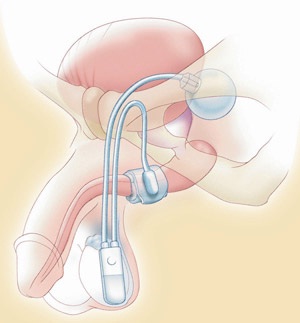Artificial urinary sphincter
The artificial sphincter ( " artificial sphincter ", other names: Artificial Blasensphinkter, Artificial urinary sphincter, artificial urinary sphincter, artificial urinary sphincter, bladder sphincter prosthesis ) is a method for treating urinary incontinence in both men and women. It can be refilled via a hydraulic mechanism cuff is placed around the urethra, they can largely take over the function of the muscle ( bladder sphincter ).
Construction
The artificial sphincter consists of three main components:
Function
The main mechanism for the recovery of continence is that the cuff squeezes the urethra from the outside, thus preventing inadvertently going urine.
The entire implant is filled with isotonic saline solution, so that its internal pressure is about 50-90 ( 61-70 ) cm water column. Is added to the filling fluid is a X-ray contrast agent, which may facilitate a later time may be necessary, the diagnosis of a malfunction.
The pressure- regulating, the liquid reservoir consisting of a balloon urges the fluid in the cuff which seals the urethra in this manner at a controlled pressure. Will the patient empty the bladder, he presses a switch of a control pump. Then the liquid from escaping from the sleeve and flows into the reservoir. The blockage of the urethra is removed and the urine can flow. When the bladder is empty, the fluid automatically flows from the tank back into the cuff and these again blocked the urethra.
The surgery in men
The implantation is usually done under general anesthesia. The procedure typically takes about 60 minutes. After shaving and disinfection of the operative field, a catheter is initially inserted into the urethra. After a cut in the perineum or at the point where the penis goes into the scrotum, urethra is exposed. The cuff is placed around the urethra, inserted the control pump in the scrotum and put the pressure-regulating balloon in the lower abdomen. The components are interconnected by tubes. The surgical wound is closed. The artificial sphincter is activated until several weeks after this surgery after complete, even inner healing. As long as the patient is still incontinent.
Also in women, this known process since 1972 is a possible option. In the severe stress incontinence of the man it is the gold standard of the surgical procedure.
Results
The results so far are good, but there is a high risk of up to 50 % in the first five years that new interventions are necessary. Risks associated with urinary tract infections, a disturbance and erosion of the urethra at the sleeve, and mechanical problems of the system. The operation of the control pump also requires a sufficient understanding and skill of the patient. Under optimal conditions, one can assume an average shelf life of five to ten years.




01246-3/assets/gr7.jpg)





